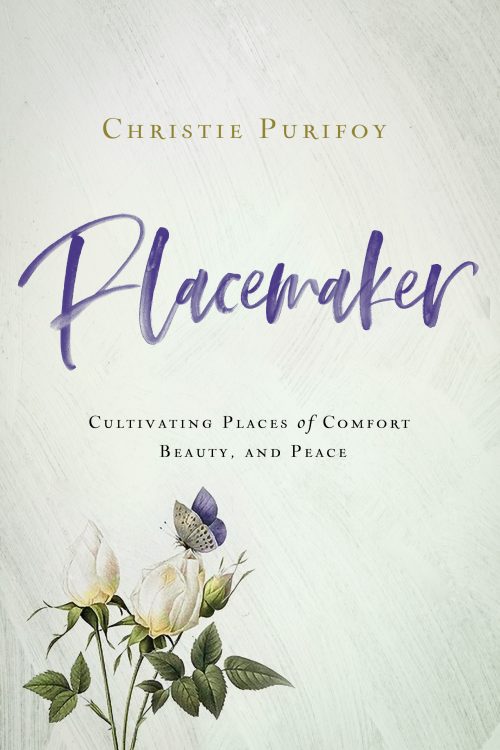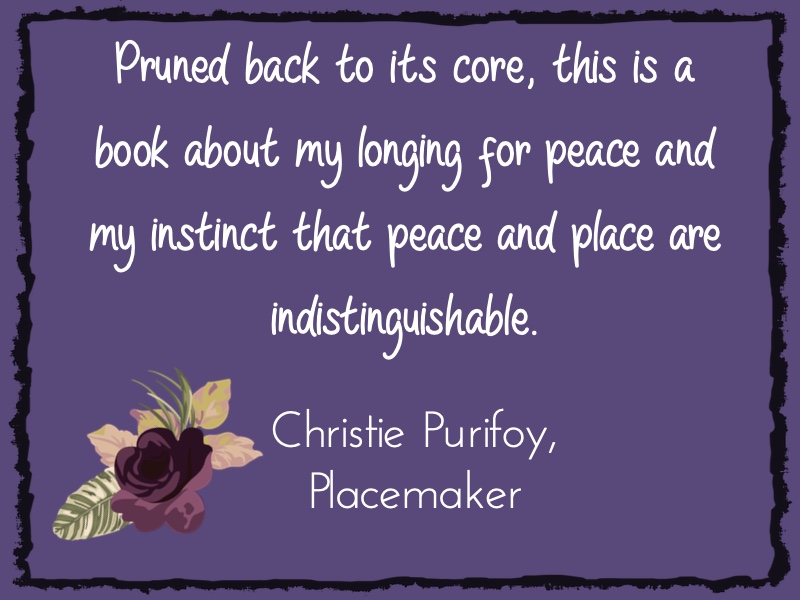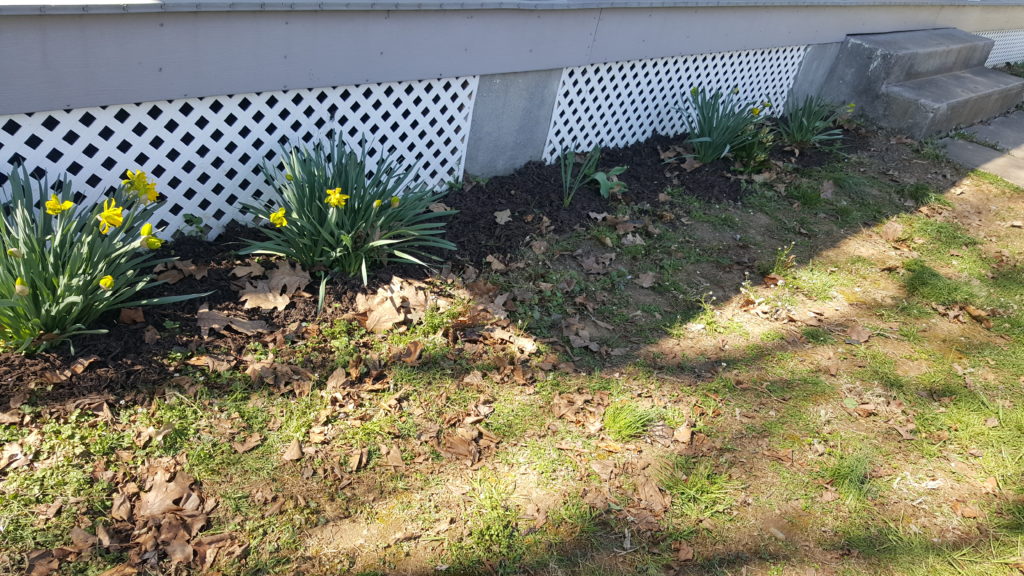I don’t know much about trees and flowers. Not in the technical sense. I know what I like–colorful blooms and bright spring buds and branches that loom large providing shade–but I struggle with remembering the names of specific kinds of trees and flowers. I have to train myself with words like forsythia and hyacinth. It has taken years for me to notice these specific types of plant life (although at this exact moment, forsythia is all I see when I drive, walk or run.)

New ways of noticing and paying attention are my personal challenges right now and Christie Purifoy’s new book Placemaker: Cultivating Places of Comfort, Beauty, and Peace contributes to that in ways I never expected.
Purifoy wrote another book, Roots & Sky, about her family’s first year at Maplehurst, the Pennsylvania farmhouse they bought and moved into. I was intrigued by that book because its setting is just a short drive from where I live and I have a thing for old farmhouses. What I loved about that book cannot even compare to what I loved about her new book, though. If Roots & Sky gave me a romantic notion that buying and restoring an old farmhouse was my dream, then Placemakerreminded me that any place where I dwell can be where dreams come to life.
I can’t say enough about the words in this book. But I’ll try.

Each chapter begins with a tree or a plant-based theme, often accompanied by the author’s recollections of that tree in places where she’s lived along with some facts and history of that tree. I hope that doesn’t sound dull because it’s far from it. My favorite chapter of the book was the one about Penn’s Woods, again because my current dwelling place is Pennsylvania and I live in an old farm house that captures my imagination sometimes.

What also appeals to me about Purifoy’s stories are that she and her family have moved several times, and some of the homes they’ve lived in have been temporary or rentals. She shows how that doesn’t have to be a barrier to making a place of beauty or comfort or peace.
“Many of us long to put down roots in some particular place, but we guard ourselves against heartbreak by waiting for a perfect place.” (p. 37)
This is me, 100 percent.
Another aspect of this book I loved is the honesty of it. Purifoy writes candidly about the challenges of owning an old farmhouse, the expenses of caring for it, even the doubts of whether it was a mistake to buy it. She also writes about the loneliness her family experienced in their various dwellings, something I can relate to in our own family’s history of moving from a familiar place to an unfamiliar one.
And she makes hospitality accessible, something I’m still learning.
“Simple food and drink may be the only absolutely necessary components of hospitality. I can welcome others even when there is a hole in the front porch where rain has rotted the boards. I can welcome others while scaffolding climbs the brick walls … I can even welcome others without air conditioning, trusting heaven for a breeze.” (p. 176)
—
That’s where I’m going to end the review portion of this post. The rest of what I have to say is about how I’m applying what I read to the place where I live.
—
It was Sunday, and we’d already had a full day, but April was right around the corner and the flowers in the ground were starting to show their colors. I wanted them to last longer, so I started clearing away the weeds and the dead leaves from fall that had collected at the base of the porch. I dumped black mulch that had collected water over the winter in between the flowers that were planted before our move to this property. They have yet to fail to bloom in spring.

The result was an improvement I could not hardly believe. It looked like we cared about the flowers. About how our property looked.
I used to think that was a bad thing, too. Like it was somehow sinful to take care of land and a home that eventually would not last. I have also believed the lie that I have to own property or land in order to invest in it. Or even to care about it.
But why not make the most of something while it is yours?
These are the lessons of placemaking.
—
The farmhouse we live in was built in 1880. That’s all I know. I can’t figure out how to find older records beyond the current owner, our landlord, and the previous one. That only takes me back to the 1990s. I don’t know why it matters so much (or why it doesn’t quite matter enough for me to spend more time on searching) but I like to imagine how things were.
And the house itself is divided in two–a first floor apartment where we live and a second floor apartment–which makes me wonder what it all looked like when it was one whole house. (The boarded up stairs in our pantry give me the smallest of clues.)
When we moved into the farmhouse, we had ideas how to make it home. I remember how we doubted whether we should plant a garden. What if we leave? That was years, and several garden plantings, ago. We did not plant the flowers that border the porch or the hydrangeas that flower by the back door. We have planted our own flowers sometimes and pruned the trees and the rose bush. We had to uproot one of the roses this year because it didn’t bloom last year. We are amateur gardeners at best and we love this place that is both country and suburban.
We can’t paint the walls. Or figure out how to add another bedroom or bathroom. We are limited by someone else’s modifications to this beautiful farmhouse that now sits across the street from a shopping center and has a small-business in its backyard next to subdivided land. We have heard whispers of the orchard that used to dot the landscape between our yard and the river. Now there are apartments next door and a country club across the river.
Does any of this mean we give up trying?
—
What have I contributed to the places I’ve lived? Another aspect of the book I enjoyed was how Purifoy weaved stories of her homes with different kinds of trees. I have lived at half a dozen addresses since I moved out of my parents’ house after college, and I’ve always thought of my homes as temporary, as if we are in a constant phase of waiting.
Here, in the farmhouse, it’s as close to a home as we’ve ever had. Our kids have grown here. It is the house they will remember.
Still, we dream of a place that is “ours.”
—
Placemaker reminded me that making a place is a community effort. And it’s okay to ask for help. And accept it.
My parents’ most recent visit illustrated this as we raked leaves and cleared flower beds and dumped bags of mulch into the flower beds. Our yard work uncovered a bird skull, which my son was fascinated by. When we were finished, I didn’t feel like we had accomplished much, but the look of our yard changed. It looked cared for. Like someone had tended it. This is what I hope for. This is what I’m still learning about keeping a house. It might not ever be spotless but it can look like someone cares. Like there is a tending taking place.
After reading this book, I’m more motivated to add personal touches to the house. To increase our hospitality not in proportion to our plenty but in proportion to our desire for community. I have dreams of bringing people together in our place, even if it means fading into the background of whatever gathering that might be. I want to be the place where people gather. Where good food is served. And conversation is as plentiful as the food.
—
I’ll end with this powerful connection between peace and place from the book:
“Placemaking is a kind of peacemaking. It is a way of making peace within families, for instances when we rearrange the bedroom furniture to better suit siblings who share a room … it is a way of making peace within communities, when we share our places through hospitality, or when communities of very different people care for a shared space such as a park or garden.” (p. 112)
Leave a Reply